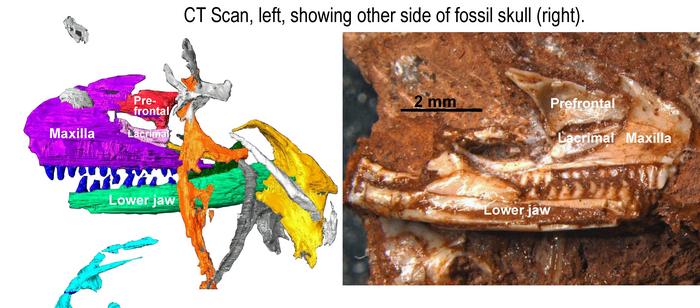A storeroom fossil that redefined the evolutionary timeline of modern lizards by millions of years has now had its identity conclusively verified.
Discovered in Triassic-era rocks from a quarry near Bristol, the tiny skeleton, dated to at least 205 million years ago, holds the title of the oldest known modern lizard. This groundbreaking find originally faced skepticism, but new research published in Royal Society Open Science reaffirms its significance. The fossil, closely linked to modern anguimorphs like monitor lizards and anguids, pushes back the origin of the Squamata group—encompassing all lizards and snakes—by 35 million years.
In their initial study, researchers Dr. David Whiteside, Dr. Sofia Chambi-Trowell, and Professor Mike Benton named the ancient creature Cryptovaranoides microlanius, meaning “hidden lizard, little butcher,” a nod to its small size, lizard lineage, and sharp teeth, likely adapted for slicing prey. Detailed analysis of its skull and skeleton placed it firmly within Squamata, particularly near the Anguimorpha subgroup.
“We anticipated some controversy,” said Dr. Whiteside. “But we were confident in our meticulous examination of every anatomical feature and comparison with existing data.”
Their surprise came in 2023 when another academic team proposed that Cryptovaranoides was not a lizard or even a Squamate relative but instead belonged to Archosauromorpha, a lineage closer to crocodilians and dinosaurs.
In response, the Bristol team revisited their findings, incorporating both the original specimen and high-resolution X-ray CT scans that revealed intricate details hidden within the rock. “The CT scans and further access to the fossil allowed us to thoroughly evaluate their claims,” explained Dr. Chambi-Trowell. “We found most of their criticisms to be unfounded.”
Professor Benton added, “The skull, jaws, teeth, and limb bones unequivocally confirm that Cryptovaranoides is a lizard, not an archosauromorph. Our new paper provides exhaustive detail to address each critique, supplemented by additional photographs and 3D scan images for independent verification.”
Dr. Whiteside emphasized the rigor of their updated phylogenetic analysis, which involved coding hundreds of anatomical traits from both modern and ancient lizards alongside archosauromorphs. “No matter how many times we ran the analysis, the conclusion was the same—this small Triassic reptile is the oldest modern lizard on record,” he concluded.
